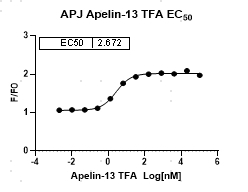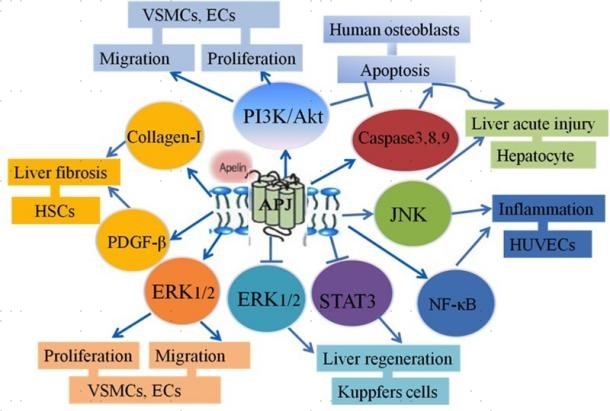l Apelin is a peptide hormone originally extracted from the secretion of bovine stomach tissue. It is an endogenous ligand for class A (retinoid like) G protein coupled receptor (GPCR) APJ and is widely distributed in the central nervous system and various organs of humans and animals; The APJ receptor protein is closely related to angiotensin II receptor type 1 (AT1R). APJ is composed of 380 amino acids and has a typical hydrophobic transmembrane domain of GPCR and a common site for cAMP dependent protein kinase phosphorylation (palmitoylation and glycosylation sites). APJ signaling is heterologous, and Apelin repeats (AR or APJ) are more likely to interact with G α I/O coupling, especially G α I1 and G α I2, but usually not G α I3. Recent studies have shown that the Apelin/APJ system plays an important role in pathophysiological functions. Apelin/APJ can inhibit inflammatory responses by downregulating the nuclear factor KB (NF-KB) pathway and upregulating the extracellular signal regulated kinases 1 and 2 (ERK1/2) pathway. Preliminary studies have shown that the Apelin/APJ system is involved in various diseases, such as cardiovascular diseases, liver and kidney diseases, neurological diseases, inflammatory bowel diseases, pancreatitis, lung injury, aging, and obesity. In addition, the lack or excess of Apelin can exacerbate the disease state, as inflammation is not only an important physiological defense mechanism, but also a potential mediator of organ damage. In summary, Apelin/APJ signaling is upregulated or downregulated through signaling pathways, including NF- κ B/JNK, ERK1/2, AMPK/GSK-3 β/ Nrf2 or Akt/PI3K can inhibit inflammation, oxidative stress, and improve central nervous system and organ damage. Therefore, the Apelin/APJ system has important anti-inflammatory effects and is involved in regulating inflammation related diseases. Apelin and APJ will become potential therapeutic targets for treating inflammation mediated or aggravated diseases.
l Cell level display data

Figure 1: APJ target test data display
l Image cited from DOI:10.3389/fphar.2017.00221

Figure2 : The role of Apelin/APJ in liver disease
Literature source:
DOI:10.1016/j.intimp.2022.108822
PREV:There's no more
2024-03-13
2024-03-13
2024-03-13
We value your inquiries and are here to provide you with tailored solutions for your drug discovery and development needs. Whether you have questions, require more information, or are interested in discussing potential collaborations, our team of experts is just a message away.
Feel free to reach out to us.